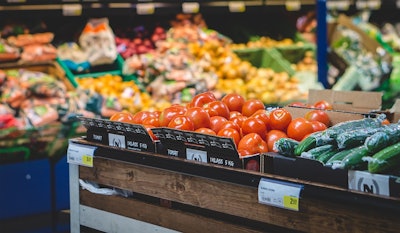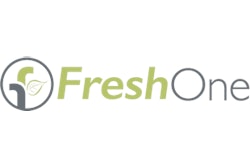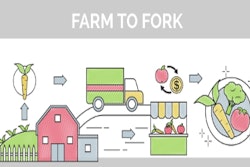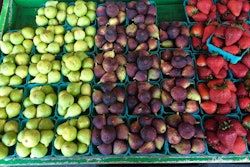
“Over the past five years, there has been a significant increase in overall fresh food offerings as retailers strive to meet rising demand from customers,” according to Duff & Phelps’ “Food Retail Industry Insights—2016.”
Fresh fruit and vegetables, healthy grab-and-go snacks, as well as fresh meats and cheeses are all on the menu today as 99 percent of consumers have reportedly begun purchasing these options as opposed to more processed versions of the same foods.
Where consumers can purchase fresh food is also changing. While grocery stores are viewing fresh offerings, including things like sushi and salads, as a means of increasing business, pharmacies, gas stations and convenience stores are also getting into the fresh food act, and stocking fresh foods on their shelves. In addition, customers are also demanding fresh foods come to them via online ordering and mobile delivery.
Clearly, the trend toward fresh is growing; so fast that the Nielsen Global Health and Wellness Report finds fresh food sales have increased by 5 percent in the last four years and predicts these sales will grow an additional 16 percent by 2020.
“New consumer trends mean that stores are going to be looking for quality food distribution companies based on their ability to get more fresh produce into stores to efficiently and safely meet growing demand,” reports FreshOne Distribution Services LLC in “What Does the Future Look Like for Food Logistics?”
Having more fresh food in the pipeline than ever before could potentially upend logistics and cold storage providers’ processes. Today, the question has become: How can these providers meet the demands of a changing landscape, where they must support longer shelf life while also comply with the regulations of the Food Safety Modernization Act (FSMA) ?
Segmenting Supply Chains
According to Markets and Markets’ “Cold Chain Report,” which forecasts the fresh fruits and vegetables, bakery and confectionary, dairy, meat, fish and seafood markets globally through the year 2022, the cold chain market is expected to grow to $271.30 billion by 2022, with dairy and frozen foods topping the list as the largest segments. However, the report also highlights an increasing focus on the number and quality of fresh products.
Better and new logistics processes will be in order to move this amount of fresh product annually, while also addressing the skyrocketing costs of food waste and loss, which is estimated at $940 billion a year. Ralpf Seifert, a professor of operations management at IMD and director of IMD’s new Digital Supply Chain program, reports this figure represents a significant portion of shrinkage in retail supply chains and has a direct impact on companies’ triple bottom lines. He suggests there could be a great opportunity here for cost savings and to reduce environmental and social footprints.
Seifert goes on to say that fresh fruits and vegetables are a challenging retail category because of their very short product lifetimes. Research done with Merve Kirci, a doctoral researcher, who looks at strategic and operational improvements in food supply chains for the College of Management of Technology at EPFL; found that the top three drivers of spoilage are excess inventory, order cycles and variation, and longer delivery times.
It is the third item on this list that concerns Dan Vache, vice president of Supply Chain Management at United Fresh Produce Association. He explains logistics providers, and warehouse, cold storage and distribution center operators, will need to reimagine their processes to deal with this paradigm shift. “When it’s a big distribution center or wholesalers, they’re more focused on the velocity of that product and making sure it flows through their system as quickly as possible,” he says. “Every time there is a delay with fresh produce [and other fresh foods], it’s quality can diminish.”
Andy Moses, senior vice president of Global Products for Penske Logistics, adds the building demand for fresh foods is increasing segmentation in supply chains. In the past, a grocery chain operated a fleet of tractor-trailers to serve all of its stores, and truckloads were delivered once a day, every other day or even once or twice a week, depending on the size of the store.
“There is more frequent replenishment of fresh items today, and it's causing, in some instances, a need for a portion of the supply chain to be managed separately and outside the broader supply chain operation,” he says. “Grocery chains still operate that large fleet but then separately, they operate a smaller network of refrigerated straight trucks to frequently replenish fresh items. No one wants to buy a salad that looks a little brown, or a sandwich that's a couple days old.”
These challenges have required logistics providers to develop processes for front-door deliveries as opposed to the traditional back of the store ones where they pull up to a loading dock and unload. “Penske’s drivers are literally coming in the same door to the store that you or I would as consumers. They are probably rotating some stock on the shelves, if it's bakery products or other fresh items,” says Moses. “There is a high- touch labor component that's very different from traditional truckload warehouse-to-dock-type delivery. The drivers have to be trained to navigate in and around consumers. That is one whole area where fresh food is changing processes from a logistics provider's perspective.”
The other impact, he says, has been on the equipment that logistics providers operate. Many companies are opting to lease as opposed to buy their refrigerated trailers. Moses believes this is why Penske is flourishing in this space, stating, “We have ready access to this type of equipment, which for some logistics providers would be less standard within their operations.”
Penske also has already upgraded the tools it uses for routing to ensure fresh food is delivered when and where customers want it. “We serve one convenience chain, as an example, where every store has to be delivered by 4:30 a.m.,” Moses says. “In other instances, we're only able to deliver at times when stores are open; and not all stores are open 24 hours a day. We needed software that enables us to accurately capture the nuances of the store environment, and then, be able to route efficiently and accordingly based on these requirements.”
Focus on FSMA
FSMA adds another layer of logistics complexity because meeting this mandate needs to be top of mind. “Everyone is feeling more accountable and understands they have a role to play in food safety,” Vache says. “Even the harvesters are feeling this. If you go watch lettuce being harvested in Salina Valley, you’ll see field workers wearing latex gloves and hair nets. Everyone is involved, educated and reminded frequently that they have a role in keeping our food supply safe.”
Making sure the cold chain is never broken is a critical element that goes hand in hand with food safety, Vache points out. For facilities handling fresh food, this has led to altering building designs, adding multiple temperature zones, and adding technology to better monitor product temperature. Shipping docks, for instance, used to be open to the elements, now they are closed. Trucks now pull in under canopies to keep sunshine off of their roofs.
Truckloads are also being monitored in real time.
“It used to be if a truck left with a load of strawberries, or whatever the product was, they would have a device in the trailer recording temperature, but it only captured temperature at the beginning and the end of the trip,” Vache says. “Now we have real-time monitoring that gives an alert to the driver, so if the temperature falls below what’s required, they know they have a quality issue.”
Penske has already added technology to track temperature while products are on the move. The company receives alerts whenever temperature falls out of tolerance. Says Moses, “We can be sitting in our office, and checking on the temperature of freight that's out on the road with the technology we use today.”
Real-time monitoring changes everything, Vache says, because now delivery decisions can be made on the fly. If a load goes above or below a specific temperature threshold, it can be diverted to a closer market to avoid condition and freshness issues. “We know we’re going to have condition issues if we don’t get the product into the distribution system more quickly,” he says. “This technology allows companies to be proactive versus reactive.”
Penske also operates more warehouse facilities with multiple temperatures, to keep each type of fresh food fresh. These facilities offer ambient cool and frozen sections to handle the wide variety of fresh food and the segmentation of the supply chain, Moses says.
“This is incredibly important,” adds Vache. “We have to cut the cool from the time food is harvested until it gets to a facility. At the facility, we need to take the heat out of it and get it down to temperatures below 40 degrees Fahrenheit [for produce]. This gets the respiration down so we can maintain the food’s quality. Because the food’s freshness never gets better, it can only get worse.”

















